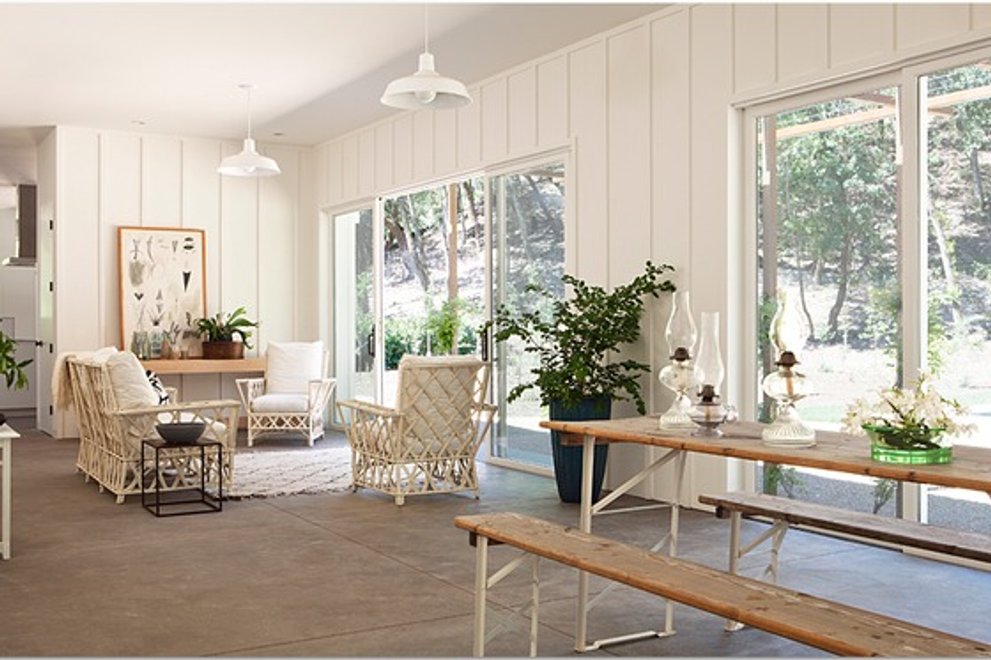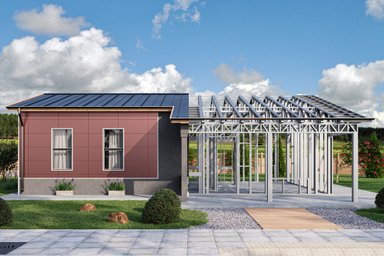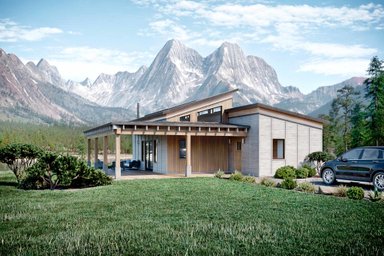Contractor Paul Sorensen
has built several Houseplans.com designs that have exposed concrete floors
(including Plan 888-2) and has helpful advice about using concrete in this way.
He explains: “Utilizing the concrete slab foundation as the finished floor can
provide significant savings in that the structural foundation system ends up
becoming the finished floor system, removing the need for wood flooring, or
some other applied finish.”
Concrete is strong in compression but does not have tensile strength, so controlling cracking in the concrete is important. It’s important to take time before the pour to develop a logical layout of control joints, (scores in the concrete where cracks are encouraged to occur). It is recommended that control joint spacing does not exceed the thickness of the concrete in inches multiplied by 2, and converted to feet. For example, a 4’’ thick concrete slab should have control joints installed at no more than 8’, a 5’’ thick slab, no more than 10’. Control joints should also extend to a depth of 25% of the slab thickness, which will effectively create a weakened area where the crack will occur. From there, it is best to center control joints in rooms, or at the intersection of walls.
Concrete achieves hardness through hydration, which is a chemical reaction between cement and water. Paul says it’s important to slow down the hydration process, which will increase the strength of the concrete. This can be done with a water cure or by using a spray-on curing compound to create a seal to keep moisture in. “The majority of strength in concrete is achieved in 7 days, and nearly all of its strength is achieved by 28 days,” he says, “so ensuring that the concrete slab is cared for, and certain practices are put to work in those early days, is essential for creating a product that will be not just good, but great. The simple fact is that the slab will likely remain in place for the next 100 years, so building something to a high level of quality will be admired by many and is important.”
With an exposed concrete floor, control joints are often cut into the slab with a concrete saw. There are dry type sawing methods and wet type methods, where water is constantly sprayed on the saw blade to keep it cool. Clean up of the waste that occurs when sawing is important.
Timing is everything when it comes to saw-cutting control joints. Depending on the weather and moisture in the environment at time of pour, saw cutting typically happens within 12-24 hours of the concrete pour. Saw-cutting too early can cause spalling, which is when the saw hits rocks, or aggregate in the concrete mix, and breaks them out of the concrete, creating a joint that is rough. Saw cutting too late increases the risk that the simple thermal expansion of the slab caused by temperature change will cause cracking where it is not wanted. It is typical to “tool in” select joints on the day of the pour, when the concrete is wet, to alleviate these thermal pressures, and to then come back the following day to cut the rest of the joints with a saw. Pouring concrete on an overcast day is ideal because the concrete cures at a slower rate -- just make sure there is no risk of rain!
With exposed concrete floors, the rough construction is the finished product and this takes a lot of pre-planning, as well as care throughout the building process to make sure the end result is as blemish-free as possible. There is no hiding behind mistakes by covering the floor with finishes, but in the end, you can end up with a great architectural look. Paul’s summation: “Exposed concrete floors have an attractive, somewhat agrarian or industrial aesthetic, not necessary suited to all projects, or environments, but a great option to consider when planning your next project.”
Concrete is strong in compression but does not have tensile strength, so controlling cracking in the concrete is important. It’s important to take time before the pour to develop a logical layout of control joints, (scores in the concrete where cracks are encouraged to occur). It is recommended that control joint spacing does not exceed the thickness of the concrete in inches multiplied by 2, and converted to feet. For example, a 4’’ thick concrete slab should have control joints installed at no more than 8’, a 5’’ thick slab, no more than 10’. Control joints should also extend to a depth of 25% of the slab thickness, which will effectively create a weakened area where the crack will occur. From there, it is best to center control joints in rooms, or at the intersection of walls.
Concrete achieves hardness through hydration, which is a chemical reaction between cement and water. Paul says it’s important to slow down the hydration process, which will increase the strength of the concrete. This can be done with a water cure or by using a spray-on curing compound to create a seal to keep moisture in. “The majority of strength in concrete is achieved in 7 days, and nearly all of its strength is achieved by 28 days,” he says, “so ensuring that the concrete slab is cared for, and certain practices are put to work in those early days, is essential for creating a product that will be not just good, but great. The simple fact is that the slab will likely remain in place for the next 100 years, so building something to a high level of quality will be admired by many and is important.”
With an exposed concrete floor, control joints are often cut into the slab with a concrete saw. There are dry type sawing methods and wet type methods, where water is constantly sprayed on the saw blade to keep it cool. Clean up of the waste that occurs when sawing is important.
Timing is everything when it comes to saw-cutting control joints. Depending on the weather and moisture in the environment at time of pour, saw cutting typically happens within 12-24 hours of the concrete pour. Saw-cutting too early can cause spalling, which is when the saw hits rocks, or aggregate in the concrete mix, and breaks them out of the concrete, creating a joint that is rough. Saw cutting too late increases the risk that the simple thermal expansion of the slab caused by temperature change will cause cracking where it is not wanted. It is typical to “tool in” select joints on the day of the pour, when the concrete is wet, to alleviate these thermal pressures, and to then come back the following day to cut the rest of the joints with a saw. Pouring concrete on an overcast day is ideal because the concrete cures at a slower rate -- just make sure there is no risk of rain!
With exposed concrete floors, the rough construction is the finished product and this takes a lot of pre-planning, as well as care throughout the building process to make sure the end result is as blemish-free as possible. There is no hiding behind mistakes by covering the floor with finishes, but in the end, you can end up with a great architectural look. Paul’s summation: “Exposed concrete floors have an attractive, somewhat agrarian or industrial aesthetic, not necessary suited to all projects, or environments, but a great option to consider when planning your next project.”






